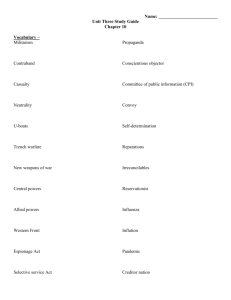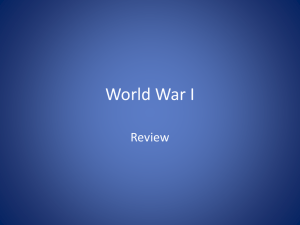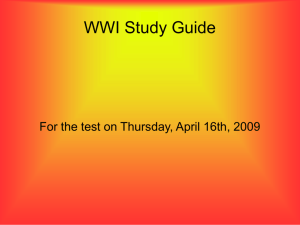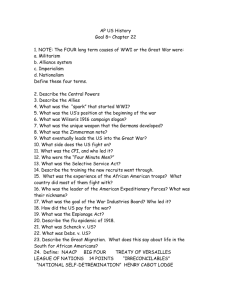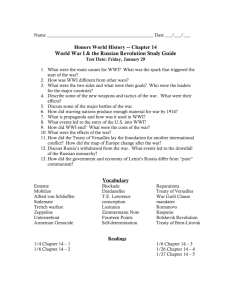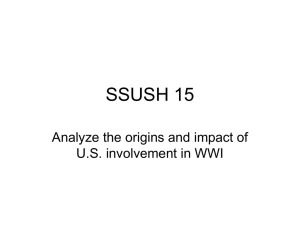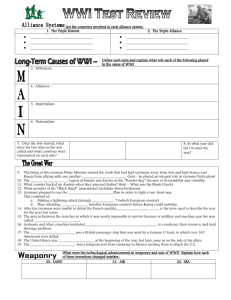Chapter 28
advertisement
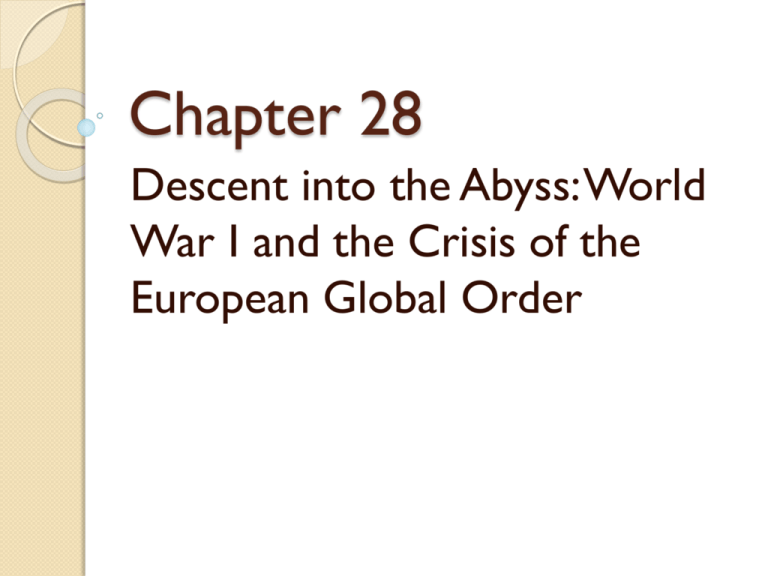
Chapter 28 Descent into the Abyss: World War I and the Crisis of the European Global Order The Coming of the Great War There were a host of different factors that led to the outbreak of WWI, including: ◦ ◦ ◦ ◦ 1) Alliance systems 2) Imperialism 3) Militarism 4) Nationalism The Coming of the Great War (#1a) A) Alliance systems ◦ Germany’s growing industrial and military power in Europe threatened the major powers on the continent (France, Russia, and Britain) ◦ Germany’s neighbors, France and Russia, allied themselves in the 1890’s to surround Germany and discourage a declaration of war or invasion by Germany. ◦ Britain responded in part due to Germany growing economic power and threatening naval capabilities. ◦ By the early 1900’s the three (Russia, France, and Britain) had formed the Triple Entente (agreement). ◦ Germany responded by allying with AustriaHungary. Pre-WWI Alliances Super-Mega Pre-WWI Alliances Venn Diagram The Coming of the Great War (#1b) Imperialism ◦ For decades, most European powers had been engaged in an imperialist rivalry around the globe. These rivalries heightened tensions between the nations. (map on p.551) ◦ Imperialist rivalries only served to further the tensions between nations and feed the jingoism (warlike nationalism) of each nation. The Coming of the Great War (#1c) Militarism ◦ Alliance systems and imperialist rivalries only helped to fuel the arms race of the early 1900’s in Europe. ◦ Naval power was the most obvious form of military buildup. ◦ Germany poured money into its navy in order to challenge Britain on the open seas. Both nations built more and better naval vessels as a result. ◦ The size of armies grew steadily to number in the millions. Each nation was preparing itself for war. Militarism Continued • • • • • • All the countries of Europe built up their armies and navies. In 1914, their armed forces stood like this: Germany: 2,200,000 soldiers, 97 warships Austria-Hungary: 810,000 soldiers, 28 warships. Italy: 750,000 soldiers, 36 warships France: 1,125,000 soldiers, 62 warships Russia: 1,200,000 soldiers, 30 warships Great Britain: 711,000 soldiers, 185 warships As one country increased its armies, so all the others felt obliged to increase their armed forces to keep the ‘balance of power’. The Balkan problem (#2) Nowhere was the tension higher in Europe than in the Balkans. Complex ethnic divisions and rivalries made this territory a hotbed of crisis. On top of this, in the years before WWI, there had been a series of regional wars in this region over territories and resources. (map on p. 535) The Balkan Problem It made the races ruled by the Ottoman Turks (such as the Romanians and the Bulgarians) and by Austria-Hungary (such as the Serbs) want to be free to rule themselves. In the Balkans this was called ‘Panslavism’ because the people who wanted to be free were all Slav races. The most nationalistic of all were the Serbs – Serbia had became an independent country in 1878, but in 1900 many Serbs were still ruled by Turkey and Austria-Hungary, and Serbia was determined to break free. This led to rebellions and terrorism which destabilized the Balkans. The Balkans in 1914 Annexed to Austria in 1908 “The Powder Keg of Europe” (#3) On June 28, 1914, the Archduke of Austria-Hungary, Franz Ferdinand visited the Bosnian capital of Sarajevo. Bosnia had been taken from Serbia by Austria-Hungary years earlier. A Serbian nationalist, Gavriel Princip, assassinated the Archduke. (you will read an article on this) Gavriel Princip’s mugshot (19 yrs. old) Franz Ferdinand’s Car Assassination leads to war Alliance System takes over (#4) Austria-Hungary responded by declaring war on Serbia (exactly one month after the assassination). Serbia was backed by Russia (defender of the Slavic race), so Russia declared war on Austria-Hungary and began mobilizing its troops to the border. Germany backed Austria-Hungary, and was worried about Russian troop movements, so it declared war on Russia. Britain and France then declared war on Germany and Austria-Hungary The Ottoman Empire joined Germany and AustriaHungary in 1915. They had for decades been reliant upon German military advisors and financiers. Alliance System WWI Causes WWI Map (Central Powers and Allied Powers) The Schlieffen Plan (#5) Germany found itself at a distinct disadvantage once war was declared, having to fight a two-front war. As a result Germany devised a plan to launch a quick and massive attack to the west (towards France) and then turn back towards the more backward less threatening Russia in the east. This plan was spearheaded by General Alfred von Schlieffen, hence the name. The Schlieffen Plan Trench Warfare (#6 p.650) Effects of WWI Weaponry (#7) On top of having devastating killing power, the weapons of WWI were best used to hold defensive positions rather than lead charges or offensive maneuvers. As a result, very little ground was gained by either side between 1914 and 1917. Direct Control from Governments (#8) As war continued, governments took more and more control over areas of both public and private life: ◦ Industrial sectors were taken over by gov’t. Factories were told what to produce and railroads were administered by the state. ◦ Massive censorship took place (Sedition Acts) ◦ Propaganda departments were created to stir public support and opinion. - As a result, WWI became the first total war in human history. War Brings Change for Women (#9) Because WWI was a total war, all members of the society were asked to participate. More than any other previous war, women’s involvement increased tremendously. Millions of women in Britain, France, Germany, Russia, and the U.S., joined the work force or military. Wages for women increased and they gained a newfound sense of confidence that was rooted in the reality of their importance to their countries and societies. War Brings Change for Women (#9) It is no coincidence that women’s liberation movements began around this time. Rising hemlines on dresses, acceptance of smoking in public, and unchaperoned dating were results. The culmination of women’s gains came after the war when each country extended suffrage. The Armenian Genocide (#10) The Ottoman Turks (part of the Central Powers), opened up war fronts in the southern region of Russia. After severe losses, the Turkish government sought to blame minorities in their empire, mainly Armenian Christians. The government lashed out in a campaign of violence, killing as many as a million Armenians from 1915-1918. U.S. Entry into WWI (#11) By 1917, much of the war in Europe had settled into a stalemate, especially on the Western Front. U.S. entry in that year would turn the tide for the Allied nations. When the war broke out in 1914, most of the American public and its leaders were indifferent toward the cause. In fact, U.S. president Woodrow Wilson had won reelection in 1916 on the campaign slogan, “He kept us out of war!” That would all change in 1917. U.S. Entry into WWI (#11) Reasons for U.S. entry into WWI include: ◦ 1) War benefited American businesses. Profits were enormous from selling food, raw materials and weapons (mainly to the Entente allies). ◦ 2) British propaganda efforts. America was naturally pro-British due to our common heritage, but the British launched a massive campaign of propaganda against Germany that influenced American public opinion. ◦ 3) Germany’s need to attack ships with their submarines to enforce their blockade on Britain and France led to the sinking of U.S. ships and death of U.S. citizens, greatly angering our nation. Armistice (#12) U.S. entry into the war was just in time. Russia had pulled out of the war in March and the U.S. entered in April. A German drive on the western front was stalled by the arrival of American troops. With casualties mounting and their armies losing ground, the Germans signed an armistice on Nov. 11,1918. Many German citizens were enraged due to the fact that German propaganda in the months before that promised a victory “within weeks”. Much of the blame was transferred by the government to socialist groups and Jewish politicians (because they were minorities). This would become a rallying cry for Hitler in the 1920s. American newspaper headline Allied representatives at Armistice signing (Nov.11, 1918) Armistice Day The War’s Effect (#13) The effects of WWI prove its devastation: ◦ 1) At least 10 million dead and 20 million wounded. An influenza outbreak in 1918 killed millions of civilians as well. ◦ 2) Hundreds of billions of dollars of damage was inflicted on cities, railroads, bridges, farms, and factories. ◦ 3) This devastation led to a global economic downturn into the mid-1920’s and contributed to the outbreak of the Great Depression. The Paris Peace Conference Once the armistice was signed in Nov. 1918, the victorious nations had to settle upon a plan for peace by signing a treaty. Over the next 7 months, representatives met in Paris to hammer out the details of the historic treaty. Though there were diplomats from all over the globe, Georges Clemenceau (France), David Lloyd George (Britain), and Woodrow Wilson (United States) were the undisputed leaders of the conference. They were known simply as “The Big Three”. THE BIG THREE From left to right: David Lloyd George, Georges Clemenceau, and Woodrow Wilson Paris Peace Conference Cont’d Because the Germans had so many overseas colonies and the Ottoman empire controlled so many lands, representatives from all these territories showed up expecting to be granted self-determination. (#15) This was an idea set forth by Woodrow Wilson that people had the right to choose their own form of government. Unfortunately, Wilson only thought this applied to white people, so Arabs, Indians, Vietnamese, and Africans did not get this privilege. Paris Peace Conference Cont’d The French were determined to punish Germany for their aggression in WWI. Germany had invaded their country twice in the span of 50 yrs. and they wanted to make sure it did not happen again. The French premier, Clemenceau, actually ran his re-election campaign on the slogan “Make Germany Pay”. He won convincingly. Paris Peace Conference Cont’d (#14) There were four major punishments for Germany. ◦ 1) War-Guilt Clause: Germany had to admit to sole responsibility for starting the war. ◦ 2) Reparations: Huge war-time damage fees that Germany was required to pay to the nations it assaulted (33 billion in US currency) ◦ 3) All German colonies were stripped from them and given to members of the Allies. ◦ 4) The German military was severely decreased. They could only have 100,000 soldiers and a limited number of battleships, but no submarines. The Versailles Diktat (#16) The final treaty to come out of the Paris Peace Conference was the Treaty of Versailles (signed at the Versailles Palace). For Germany, it was nothing more than a diktat, or dictated peace, with no room for negotiation. German representatives were not even invited to Paris until May of 1919 and were never consulted or asked for input. Additionally, they were lodged in the most run down hotel in Paris, brought in through the servants door to the palace and made to stand for hours while the treaty was read to them. SIGNING OF THE TREATY OF VERSAILLES The Hall of Mirrors What about Austria-Hungary and the Ottoman Empire (#18) Germany was not the only country punished. AustriaHungary’s empire was carved into several new nations (Czechoslovakia, Hungary,Yugoslavia). The Ottoman lands in the Middle East were not given independence, but instead became mandates (territories whose control was swapped from one nation to another) of Britain and France. Italy and China lost land despite fighting with the Allies. Russia lost more land than any nation even though they were members of the original Triple Entente’. Because they quit the war early and were now Communist, they were an easy target for punishment. (#17) American response to the Treaty (#19) Even the United States public and legislature were worried about the faults within the treaty, but mainly they did not want to tie themselves to European affairs in the future. Despite the fact that Woodrow Wilson was one of the main contributors to the treaty, Congress refused to sign. The main issue they were worried about was the League of Nations, an international peace-keeping body, that had been Wilson’s idea all along. The U.S. signed a separate treaty with Germany. AMERICAN POLITICAL CARTOON RESPONDING TO THE TREATY WWI’s impact on nationalism (#20 and 21) When the war broke out, European powers moved quickly to bring in soldiers from their colonies. These territories were promised self-rule or independence for their cooperation. (#21) With soldiers being recalled to Europe to fight, most colonies seized upon this lack of force as an opportunity to push for independence. (#20) As you probably guessed, when the war ended, European powers repeatedly reneged on their promises. The combination of broken promises with a limited number of European military officials present (because they had been recalled to Europe for the war) led to intense nationalist movements. Indian Nationalism (#22) Because India was so valuable to the British Empire, the Brits were not willing to part with it despite the promise they made before the war. Western-educated Indians, many educated in British schools that had been built in India, demanded more political authority and formed the National Congress Party. British officials supported this group initially, for they saw it as a forum where the opinions of educated Indians could be heard, thereby watering down any potential political unrest. INDIAN NATIONAL CONGRESS COMMEMORATIVE STAMP Indian Nationalism Cont’d (#23) Despite the creation of this political body for representation, all Indians were united in a common bond, their disdain for British rule. This was chiefly due to British racism. No matter their caste, language, or religion, the British viewed all Indians as inferior. What began to emerge as a result was a powerful force, Indian unity. This nationalism was something the subcontinent had never experienced before. It would eventually win them their independence. Violent or Non-violent protest?? (#24a) The methods for bringing about change in India were as varied as the people themselves. However, they more or less fell into two groups, militant or non-violent protests. ◦ Radical Hindu leader, B.G. Tilak, promoted a nationalism built upon traditional Hindu beliefs (ignoring Indian Muslims). ◦ He used religious festivals for Hindu gods as a platform for mass demonstration. ◦ He endorsed several tactics like boycotting British goods, refusal of Indians to serve in the British military, and violence if the British refused to cooperate. Violent or Non-violent protest?? (#24a) Tilak’s message caught on and by the 1920’s there were frequent terrorist attacks against British officials and government buildings. In response, the British passed the Rowlatt Act, which placed severe restrictions on several Indian rights. Local protests escalated, but this time with a different message of non-violence, spearheaded by Mohandas Gandhi. Violent or Non-violent protest?? (#24b) Gandhi certainly was a revolutionary figure in India. Physically speaking, he did not embody a freedom fighter. He was of average height and very slight of build. However, he was extremely intelligent, well-organized, confident and articulate. What he lacked in physical stature, he made up for in his commitment to morality and self-discipline. Violent or Non-violent protest?? (#24b) His strategy for independence was actually born in South Africa, where he had worked a decade earlier to gain rights for Indian immigrants in that country. This non-violent protest, or satyagraha, as Gandhi called it, included boycotts against British goods, strikes, noncooperation, and mass demonstrations. While it was peaceful, it was also very aggressive, as Indians actively disobeyed British laws that they deemed unjust. As a result, it is sometimes called “passive resistance”. B.G. Tilak Mohandas (Mahatma) Gandhi Indian Revolutionaries The Zionist Movement As we have seen, in order to obtain support for the war, the British made dozens of promises that they never intended to keep. Two of these pertained to the Arab heartlands of the Ottoman Empire. First of all, Arab independence was promised in exchange for their support against the Ottomans. Instead, Britain and France made mandates out of these territories. As a result, they faced stiff resistance in places such as Syria, Lebanon, Jordan, and Iraq. They had also promised prominent and wealthy Jews a homeland in Palestine for their support. So to recap, the British managed to promise Arabs their independence and Jews a homeland (taken from Arab territory). They failed to follow through on either. The Zionist movement (#25) As a result of these promises to Jewish leaders, a Zionist movement sprang up after WWI. This was essentially a call for the Allied powers to create a Jewish homeland in Palestine (Arab territory at the time, but it had once been the kingdom of Israel) The World Zionist Organization was created to rally for this cause. The Zionist Movement (#26) The Zionist Movement was strengthened by three other events of the early 1900s: ◦ 1) The Balfour Declaration- a promise by British foreign secretary, Lord Balfour, to promote the establishment of a Jewish homeland in Palestine after the war (despite promises to Arabs that they could control their own lands). ◦ 2) Pogroms- in the late 1800’s, a wave of violent assaults on the Jewish community in eastern Europe (particularly Russia and Romania) convinced Jewish leaders that their own homeland was necessary to avoid these persecutions. ◦ 3) the Dreyfus Affair- Alfred Dreyfus, a French army officer and Jew was accused (falsely) of selling military secrets to Germany. He was not offered a trial and was treated inhumanely in the months after his arrest. The event drew worldwide attention toward the anti-Semitism in Europe.

